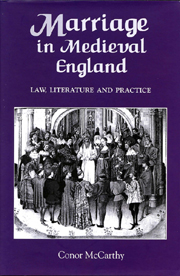1 - The Principle of Consent
Published online by Cambridge University Press: 12 September 2012
Summary
The Early Middle Ages
When the Church canonists of the central Middle Ages considered the question of what created a marriage between two people, the conclusion that they came to was that it was the consent of the persons to be married which created the marital bond. It was not necessary for a public ceremony to be held, or for their families to consent, although these things were seen as desirable, and were recommended by the Church. Nor were people considered to be married simply because of long cohabitation, or the birth of children. Rather, the bond of marriage was created through each person speaking words of consent in the present tense-‘I N. accept you as mine.’
The notion of consent as an important factor in the making of marriages was not a new one when the medieval Church formulated its consensual model of marriage: indeed the emphasis on consent in the canonists' formulation may owe something to the Roman emphasis on consent as a fundamental aspect of the marriage bond. We can also see evidence of the importance of consent (albeit as one of a number of factors) in the making of marriages in Anglo-Saxon England. The text Be wifmannes beweddunge, ‘Concerning the Betrothal of a Woman’ (c. 975–1030), a prescriptive text describing how marriage agreements are to proceed, begins by stating that if a man wishes to betroth a maiden or a widow, the proposal must please her and her kinsmen.
- Type
- Chapter
- Information
- Marriage in Medieval EnglandLaw, Literature and Practice, pp. 19 - 50Publisher: Boydell & BrewerPrint publication year: 2004



